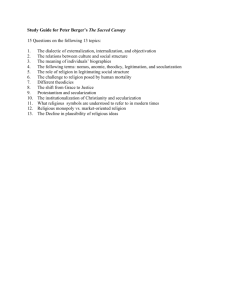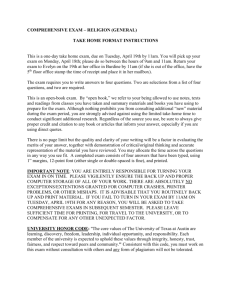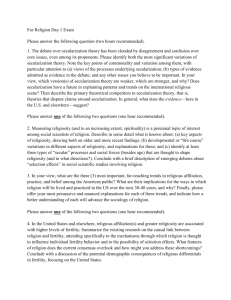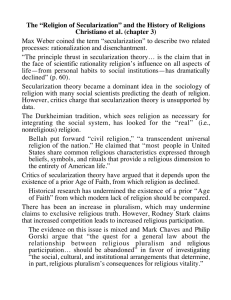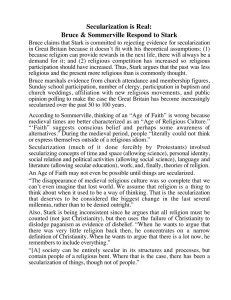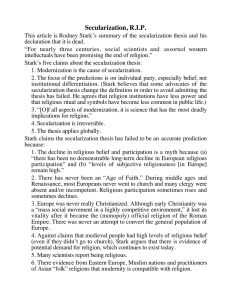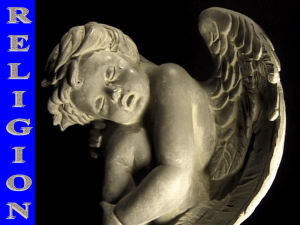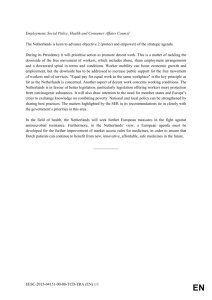Historical roots of secularization in the Netherlands
advertisement
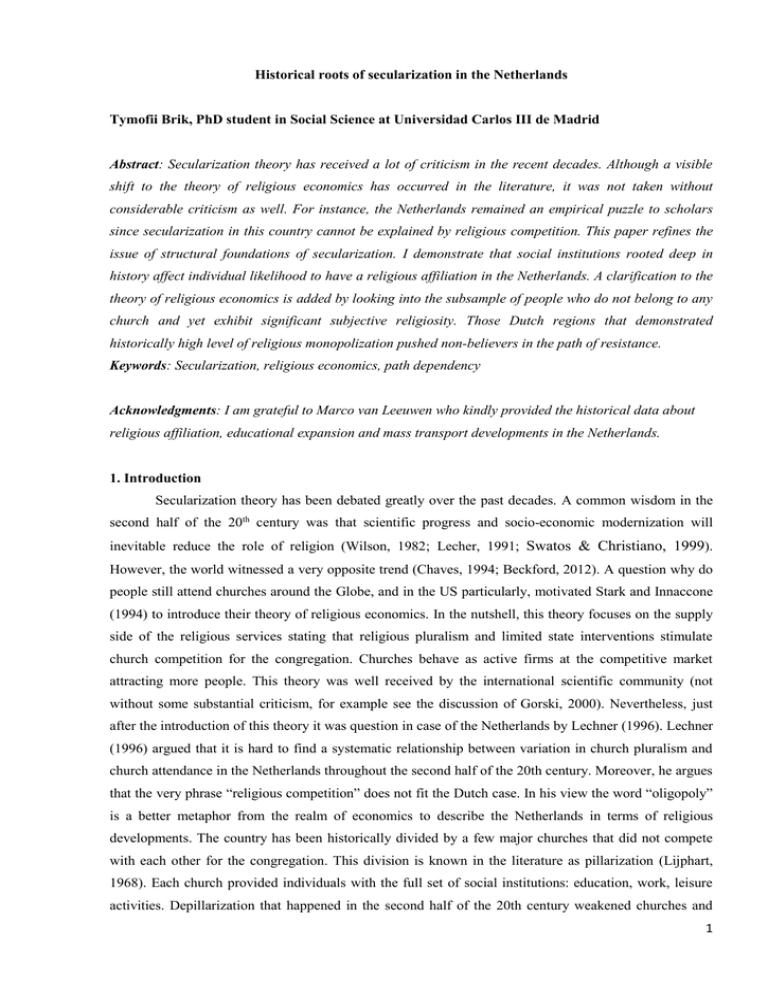
Historical roots of secularization in the Netherlands Tymofii Brik, PhD student in Social Science at Universidad Carlos III de Madrid Abstract: Secularization theory has received a lot of criticism in the recent decades. Although a visible shift to the theory of religious economics has occurred in the literature, it was not taken without considerable criticism as well. For instance, the Netherlands remained an empirical puzzle to scholars since secularization in this country cannot be explained by religious competition. This paper refines the issue of structural foundations of secularization. I demonstrate that social institutions rooted deep in history affect individual likelihood to have a religious affiliation in the Netherlands. A clarification to the theory of religious economics is added by looking into the subsample of people who do not belong to any church and yet exhibit significant subjective religiosity. Those Dutch regions that demonstrated historically high level of religious monopolization pushed non-believers in the path of resistance. Keywords: Secularization, religious economics, path dependency Acknowledgments: I am grateful to Marco van Leeuwen who kindly provided the historical data about religious affiliation, educational expansion and mass transport developments in the Netherlands. 1. Introduction Secularization theory has been debated greatly over the past decades. A common wisdom in the second half of the 20th century was that scientific progress and socio-economic modernization will inevitable reduce the role of religion (Wilson, 1982; Lecher, 1991; Swatos & Christiano, 1999). However, the world witnessed a very opposite trend (Chaves, 1994; Beckford, 2012). A question why do people still attend churches around the Globe, and in the US particularly, motivated Stark and Innaccone (1994) to introduce their theory of religious economics. In the nutshell, this theory focuses on the supply side of the religious services stating that religious pluralism and limited state interventions stimulate church competition for the congregation. Churches behave as active firms at the competitive market attracting more people. This theory was well received by the international scientific community (not without some substantial criticism, for example see the discussion of Gorski, 2000). Nevertheless, just after the introduction of this theory it was question in case of the Netherlands by Lechner (1996). Lechner (1996) argued that it is hard to find a systematic relationship between variation in church pluralism and church attendance in the Netherlands throughout the second half of the 20th century. Moreover, he argues that the very phrase “religious competition” does not fit the Dutch case. In his view the word “oligopoly” is a better metaphor from the realm of economics to describe the Netherlands in terms of religious developments. The country has been historically divided by a few major churches that did not compete with each other for the congregation. This division is known in the literature as pillarization (Lijphart, 1968). Each church provided individuals with the full set of social institutions: education, work, leisure activities. Depillarization that happened in the second half of the 20th century weakened churches and 1 made people to be individual consumers of religious services only in the course of time. Making these observations, Lechner argues that the theory of religious economics lacks social structural components in describing religious actors: “In the Netherlands, both suppliers and consumers were subjects to forces beyond their control” (Lechner, 1996, p.261). He argues that it is necessary to study church competition in a broad context of social institutions in order to better understand the case of the Netherlands, and maybe other societies as well: “Once we know the stage, inferences about the behavior of rational actors follow” (Lechner, 1996, p.261). The aim of this article is to answer the call of Lechner after almost 20 years since his article was published. The key question here is to what extend secularization in the Netherlands is a product of pillarization and other important social institutions that are tracked down to the times of socio-economic modernization? My research contributes to the literature in a threefold way. First, lately a lot of Dutch religious studies shifted to investigation of particular social groups, often minorities such as Muslims, Orthodox Protestants, believers only (Achterberg et. al, 2009; Rujs et al., 2011; Rujs et al., 2012; Maliepaard et.al, 2012). The overall secularization in the society and its link to social institutions was not studied (with an exception when the Netherlands were studied in the cross-national perspective, for example Hirschle, 2013). I shift scientific attention back to the “big picture” of secularization and its institutional foundation. Second, I merge census and other historical data with survey data derived from European Social Survey placing secularization of the Netherlands in a deeper historical context. Finally, my theoretical contribution is a qualification to Stark and Innaccone’s theory. I will demonstrate that competition of churches is indeed important for individual religiosity in the case of the Netherlands, however, only for those people who do not belong to a particular church, since church monopolization and competition affect the resistance of officially non-believers. 2. Country context Sociological studies demonstrate that the rates of personal religiosity in the Netherlands dropped more than in almost all other countries in the World (Norris & Inglehart, 2004). The growth of GDP in Holland during the last four decades correlates with the decline of church attendance. However, the change in beliefs is “only minimally associated” with economic growth (Hirschle; 2013). Achterberg et. al (2009) spotted a very important trend in secularization which is a divergence between those who do believe and those who do not. They show that overall fewer people in the Netherlands are subjected to faith; however faith becomes increasingly significant for those who do believe. Some case studies of the Orthodox Protestants or Turkish and Moroccan Muslims illustrate this thesis showing a religious revival for these small groups of believers (Rujs et al., 2012; Maliepaard et.al, 2012). These findings are important departure points for the present research since they demonstrate that secularization is a complex social process. It can be decomposed into different dimensions such as denomination membership, frequency of church attendance or personal religiosity. It may be as well driven by different mechanisms in case of believers and non-believers. 2 What are the historical developments in secularization in the Netherlands? The dynamic of changes in religious affiliation and church attendance for the recent decades can be seeing in Figure 1 and Figure 2 respectively. According to the Dutch Central bureau of statistics there were 44% of people with no denomination, 27% of Roman Catholics, 6% of Protestant church of the Netherlands, 8% of the Dutch reformed, and 3% of Calvinists in 2009. These figures are complemented with the fact that more than 70% of people hardly ever visited a church in the same year. Figure 1. Individuals of a certain religious affiliation, %, the Netherlands, 1997-2009 50 40 30 20 10 0 No denomination Roman Catholic Protestant Church of The Netherlands Dutch Reformed Calvinist Other denominations Source: Centraal Bureau voor de Statistiek, www.cbs.nl Considering deeper historical trends, demographic data shows that in 1899 only 2% of population was registered as being without any church affiliation, this increased to 18% in 1960 and 42% in 2008 (CBS, 2009). Figure 2. Church attendance, %, the Netherlands, 1997-2009 80 70 Once a week or more 60 50 40 Twice or three times a month Once a month 30 20 Less than once a month 10 0 Hardly ever Source: Centraal Bureau voor de Statistiek, www.cbs.nl 3 3. Methodological strategy In order to study social institutions that may affect secularization in the Netherlands I will conduct an investigation in two steps: by looking into church affiliation and subjective religiosity. Church affiliation is studied as having a denomination versus having no denomination. I use this indicator because of a several reasons. First of all, it reflects an overall trend of a departure from a church over time. Second, this indicator is present in different sources of data such as censuses, demographic observations and sociological surveys. Using this reliable measure I can track down in history whether secularization is framed by social institutions in a way expected by Lechner (1996). There are reasons to focus on subjective religiosity as well. Recent studies demonstrate that religion plays different role for believers and nonbelievers. Achterberg et. al ( 2009) studied a group of believers in the Netherlands showing that for them the role of religion increased over time. However, the studies of officially non-believers (those who do not belong to any particular denomination) are scarce. It is not clear whether religious attitudes vary within this group and why. This question is of particular interest to my study because it may put conflicting expectations of Stark and Innaccone (1994) and Lechner (1996). According to the theory of religious economics, a church may recruit new members who are not necessarily engaged in religious activities at the moment but possess a potential to become a consumer of religious services in future. This potential can be measured in terms of subjective religiosity. Considering, the logic of Lechner (1996), pillazrization created an “oligopoly” instead of “free religious market”. The institutional power of a church may linger in the attitudes of non-believers. Individuals may not belong to a denomination but still be religious due to the strong presence of religious institutions in the context where they live. 4. Historical developments of secularization in the Netherlands Historical data derived from the census conducted in 1909 allow measuring a proportion of individuals who were members of a particular denomination and those who did not belong to any of them. I use census of 1909 instead of earlier data because of a several reasons. First of all, at this time pillarization has been greatly developed. Catholics and Protestants had their trade unions, educational institutions, press, and political parties (Lijphart, 1968). Second, this is a time of considerable socioeconomic modernization and educational developments in the Netherlands (Wintle, 2000). Stark and Innaccone (1994) propose to look at the church competition by means of Herfindahl index. This index is used by economists to measure the level of monopolization in a given industry and is often denoted as HHI as an acronym of the more common name Herfindahl–Hirschman Index. It is defined as the sum of the squares of the market shares of firms. Market shares in this case are fractions of each firm within the industry. The final index is in a range from 0 to 1 where 0 means a significant number of competing firms, whereas 1 means a presence of a single monopolistic firm. Stark and Innaccone (1994) use this index in their models associating it with church attendance around the world. In the next part of the text the same index will be computed based on the Dutch demographic data for 1909 and 2008 years on the level of provinces. I use provinces because of the idea 4 of pillarization, since the Netherlands were divided geographically between Protestants in the North and Catholics in the South. Figure 3. Herfindahl–Hirschman Index, the Netherlands, 1909 and 2008 1 0.9 0.8 0.80 0.7 0.69 0.6 0.58 0.5 0.4 0.3 0.2 0.89 0.84 0.39 0.30 0.29 0.22 0.39 0.23 0.40 0.21 0.42 0.43 0.27 0.29 0.43 0.48 1909_HHI 2008_HHI 0.20 0.21 0.24 0.1 0 Sources: for 1909 I use census data, for 2008 I use aggregated data derived from the Tabel 5.3. Bevolking van 18 jaar en ouder naar kerkelijke gezindte en kerkbezoek naar provincie, 2008 (CBS, 2009). As it can be seen from Figure 3, overall monopolization of churches slightly decreased during the hundred years. Figure 3 reveals as well that the index of monopolization in 2008 is highly associated with the same index in 1909. Interpretation of these figures must be careful given at least two important facts. First, shares of fifteen different churches were utilized to construct index for 1909. In 2008 many of these churches ceased to exist while, for example, the Islamic churches appeared. Only five churches were utilized for the HHI calculations in 2008. Second, in 2008 only adults older 18 were analyzed, which was not the case for 1909 where all population was taken into account. Nevertheless, given the serious changes in composition of churches and some methodological differences in population selection, the overall picture of church monopolization remained the same. The South remained to be monopolized by Catholics (Limburg and North-Brabant), while the Northern Protestant Provinces remained to be less monopolized by a single church. For instance, values of HHI for Limburg (most monopolized) and NorthHolland (least monopolized) are almost the same after 100 years. But what can we say about secularization in 1909? How many people were registered as without any denomination? In order to investigate it I provide numbers on the level of municipalities in Table 1. Even though the mean number of people with no church affiliation was almost 2% in 1909, the 5 variation among municipalities is sometimes striking. Sometimes there were around 30% of people with no church affiliation in a municipality which is a quite high figure even by up to day standards. Table 1. Descriptive statistics of secularization per municipality in 1909, the Netherlands Being without any denomination N Mean Median SD Min Max 1142 1.81 0.43 3.65 0 34.84 Figure 4 demonstrates the map with distribution of secularization per municipalities. Each municipality is marked with a red dot. A size of the dot represents a share of people with no church affiliation. It is evident that the South of the country (Limburg and North-Brabant regions) did not experience secularization (the map is almost blank in this regions); at the same time Protestant territories in the North and mixed religious territories in the Center experienced a significant variation in secularization in 1909. Figure 4. Secularization by municipalities in 1909, the Netherlands Source: 1909 census derived from the CBS software StatLine Figure 4 provides an intuition that secularization began in the Netherlands quite early and with different speed by regions. To what extend these developments may linger up to the present time? In order to illustrate this relationship between the past and the present of religious developments and 6 secularization in the Netherlands I merge census data from 1909 and survey data from ESS (2002-2008). The data will be discussed elaborately later in the text. I use the system of Dutch “COROPS” or NUTS-3 units in order to merge data. Overall, there are 40 NUTS-3 units. First, to illustrate the data I present the HHI index again. This time on the level of NUTS-3 subregions instead of provinces. Figure 5. Correlations between HHI in 1909 and 2000s on the level of 40 NUTS-3 subregions, the Netherlands. The correlation of monopolization index on the level of NUTS-3 units in 1909 and 2000th is very strong (0.84). The next graph (Figure 5) demonstrates stability in church departure trends over the course of 100 years on the level of NUTS-3 units. I calculate proportions of people with no denomination in a respective subregion in 1909 and 2000s. The correlation of church departure is quite strong (0.56). Figures 3 to 5 are simple correlations on the cross-sectional level. Nevertheless, they point out that the theory of religious economics by Stark and Innaconne (1994) cannot be applied directly in its simplest form to the Netherlands. Catholic regions that experienced monopolization had higher rates of church affiliation. At the same time Protestant North that had more church competition lost a considerable piece of its congregation. Stark and Innaccone’s theory predicts otherwise stating that monopolization should have increased church departures. Hence, I provide some historical credibility to the critical comments of Lechner (1996). 7 Figure 6. Correlations between proportions of people who do not belong to any denomination in 1909 and 2000s on the level of 40 NUTS-3 subregions, the Netherlands. Historical data reveal a case of path dependency in church monopolization in the Netherlands. Some regions maintained their level of HHI over the course of time despite the two world wars, economic fluctuations and changes in churches composition. Moreover, regions with higher rates of church departure in 1909 demonstrate higher departure figures in 2000th. This path dependency has to be taken into account when analyzing secularization in the present days. The data also pose more questions. For example, what were the reasons for people to depart from churches so actively in 1909? Since the logic of competition provided by Stark and Innaccone cannot be applied, what were the institutions that overtook the power of church in the North of the country? To address these issues and study secularization in the present day Netherlands as a product of historical path dependencies I will move from correlations to statistical inferences by means of regression modeling. My first set of hypotheses puts a contradiction between Star and Innaccone (1994) and Lechner (1996) to the test. Religious economics theory predicts that a person who lives in a competitive religious market is more likely to be religious. At the same time a logic proposed by Lechner (and a historical verification of this logic provided in the previous part of the text) states that a historical power of a church as institution increases a likelihood of a person to be a member of this church. Stark and Innacone’s logic of religious economics motivates the H1.1 hypothesis, and Lechner’s logic motivates the H1.2 hypothesis. 8 H1.1. a person who lives in a region with historically higher rates of church monopolization is more likely to belong to a particular church themselves. H1.2. a person who lives in a region with historically higher rates of secularization is less likely to belong to a particular church themselves. My second set of hypotheses, as it was mentioned in the part of methodological strategy, is concerned with subjective religiosity among those individuals who do not belong to any denomination. Just like in the first set of hypotheses, the conflicting propositions of Stark and Innacone and Lechner are placed against each other. H2.1. People with no denomination are going to be more religious in those regions that were more religiously monopolized H2.2. People with no denomination are going to be more religious in regions with historically lower secularization 5. Data, methods and variables. Data For this study a few datasets are merged. Historical data come from a various sources all kindly provided by Marco van Leeuwen and Ineke Maas from Utrecht University. Church affiliations per municipality in 1909 are derived from the StatLine software of the Centraal Bureau voor de Statistiek (CBS). Variables of socio-economic modernization are retrieved from HISCI_NL dataset (Historical International Standardized Community Indicators, the Netherlands). All these historical data were collected as a part of HISMA project that investigates consequences of socio-economic modernization in the Netherlands in terms of social stratification and mobility1. Survey data is derived from European Social Survey (2002-2008). Four rounds of ESS survey in the Netherlands were selected because of their sampling design. In 2002-2008 years Dutch sample was based on so-called “COROPS” that correspond to NUTS-3 units. According to the ESS manual, Dutch ESS sample is representative on the level of COROPS. The overall number of these subregions is 40 which allow detailed spatial comparisons. Data merging is an important part of the current research. All historical data originally are on the level of municipalities. Historical data were merged on the level of NUTS-3 units first and then merged with the ESS data on the level of respective units. In the beginning of the 20th century there were more than 1000 municipalities in the Netherlands. This number was around 400 in the 21th century. While many European countries increased the number of their municipalities during the course of the previous centuries by conquering new territories and shifting from rural to urban zones, the Netherlands took another way. A lot of Dutch municipalities disappeared over time by means of various administrative reforms. In order to fit historical municipalities to the present day NUTS-3 units the code-book “Repertorium van Nederlandse gemeenten 1812-2006” (Van der Meer & Boonstra, 2006) was used. This 1 http://hisma.org/ 9 codebook lists all historical names of the Dutch municipalities and all historical changes of their borders. For instance, such changes are listed as “merging with another municipality” or “emergence from another municipality”. Very rarely some municipalities shifted to another states (Belgium and Germany) and had to be excluded from the analysis. In some cases web-pages of the Dutch provinces and Wikipedia pages of municipalities were used in order to track all changes in borders of some municipalities. An important issue is how to treat those Dutch territories that emerged very recently? The twelfth Dutch province Flevoland was established in 1986. Although the vast majority of the municipalities in this province were established in the same year, there are a few municipalities that can be tracked down to the smallest municipalities that existed on the borders and subordinated to other provinces (for instance, such municipalities as Warffum or Urk). These municipalities were merged separately and labeled as Flevoland rather artificially. It is clear that the direct link between a few municipalities in 1909 and a very new and modern region of Flevolend in 2000th is more than questionable. Nevertheless, I believe it is wrong to merge these municipalities to the bordering provinces since their administrative history is very different. Method To test the first round of hypotheses binominal multilevel regression is used. Multilevel regression model is used to test the second set of hypotheses. OLS models utilize the whole data creating spurious significance (Hox, 2010) while multilevel models take into account regional allocation of observations. The variation between NUTS-3 regions is modeled. Random effects Level 2 variance was calculated with the Latent Variables method in the case of binominal multilevel regression. Variables I have two dependent variables for the two set of hypotheses. The first one is whether a person has no denomination; the second one is the subjective religiosity. The list of independent variables is the same for the both tests. Dependent variables 1. A dummy variable from ESS with 0 when a person has a denomination and 1 when a person does not have a denomination. 2. Subjective religiosity is measured by the ESS item “How religious are you” on the 0-10 scale. Only people whose subjective religiosity is larger than 0 are included to the analysis. Independent variables Nonbelievers are the share of people with no denomination in 1909 on the level of NUTS-3. The Herfindahl index (HHI) is a measure of monopolization by a certain church (ranges from 0 to 1) in 1909 on the level of NUTS-3. Overall, 15 churches are in the index. 10 Education and mass transport. Correlations of shares of nonbelievers and HHI in the first part of the paper revealed that religious monopolization was not linked to the departures from churches. Since the logic of Stark and Innacone’s theory cannot be applied to explain secularization in the past it is necessary to test an alternative reason of secularization in the Dutch history. Numerous researchers pointed out that economic development and education may have influenced secularization (Hirschle, 2013). The link between religiosity, economic development and education is discussed elaborately by Becker & Woessmann (2009). However, it is little known whether historical developments in educational and economic systems still have shadow on the present day secularization. To study this educational expansion and train station shares are included to the analysis. Educational expansion is measured as is the number of enrolled pupils per 100 in a region in 1909. A share or municipalities that have a train station in a NUTS-3 region in 1909 is utilized to study whether secularization is linked to economic developments in the past. Muslims, migration and GDP. Present day secularization is often considered as a product of only present day developments in a society. It is important to control for these types of variables in terms to prove that historical variables are actually at work. GDP per capita in 2000 on the NUTS-3 unit levels is used to control for the economic development of subregions. Net migration in 2000 on the NUTS-3 level is used for two reasons: 1) it is an alternative control for the economic development; 2) it is a way to control for socialization effects when a large part of the population was grown in one religious context but contribute to the aggregated numbers of secularization in another context. Muslim shares in each ESS round on the level of NUTS-3 are used in the model to account for changes in church compositions since Islamic religious were not present on such large scale in 1909. Values of GDP and net migration are centered in the models. Controls on the individual level. Such controls as age, gender (being a man), ISEI, and whether a respondent was born in the Netherlands are used in the models. In this way it is expected to control for various sources of secularization pointed out in the literature: generational replacement, gender socialization, national based socialization, social status socialization. Table 1 includes descriptive statistics for the dependent and independent variables. It worth mentioning that descriptive statistics show that the minimum number of pupils enrolled in 1909 per NUTS unit was 0. Zuidwest-Friesland was the only one region with no pupils. Most likely, children from this region had to attend schools in neighboring regions. However, the neighboring regions were subordinated to the same Protestant pillar, hence this case is not considered to be problematic. 11 Table 2. Descriptive statistics N Mean Median SD Min Max Being without any denomination 7912 0.57 - - 0 1 Subjective religiosity (all sample) 7912 4,98 6 2,99 0 10 Subjective religiosity 3298 4,76 5 2,35 1 10 Nonbelievers in 1909 (proportion) per NUTS unit 40 4.2 3.3 3.9 0.15 21.2 HHI in 1909 per NUTS unit 40 0.51 0.42 0.20 0.27 0.96 Share of municipalities with trains in 1909 per NUTS unit 40 0.30 0.26 0.17 0.08 1 Educational expansion in 1909 40 0.83 0.72 0.43 0 2.6 GDP in a region in 2000 40 25,780 23,800 5420.437 16,200 39,260 Net migration in 2000 40 1911 1452 2091.407 -1693 8339 Muslim share (from ESS) 40 2.32 2.15 1.94 0.00 6.83 Age 7912 48.9 48 17.48 15 95 Male 7912 0.46 - - 0 1 ISEI 7912 47 49 16.46 16 90 Born in the country 7912 0.92 - - 0 1 (nonbelievers whose religiosity is higher than zero) 6. Results. Table 3 includes three models testing the first set of hypothesis. Dependent variable in this case is the odds ratio of an individual to be without any denomination. Model 1 includes only historical variables of religiosity and individual controls. Model 2 includes the same variables and historical variables for socio-economic modernization and controls. Model 3 includes all previous variables as well adding controls for modern socio-economic developments. Model 1 shows that church monopolization in the past does not affect the odds rations of an individual to belong to a church today. Hence, an expectation of Stark and Innacone is not confirmed from the historical perspective. On the other hand, higher rates of people with no denomination in 1909 indeed positively affect odds ratios of an individual to be without a denomination in 2000 th (although the size of effect is quite small). Model 2 includes more historical variables: share of municipalities with train stations (economic development) and amount of pupils enrolled per 100 (social modernization). This model reveals that economic developments do not affect church belonging over time. However, education is very important in shaping secularization. Individuals have higher odds to have no denomination in those regions where education was more developed historically. 12 Table 3. Binominal multilevel regression. Individual departure from church Model 1 Model 2 Model 3 0.52 (0.25)* 0.28 (0.30) 0.28 (0.30) 0.05 (0.01)*** 0.05 (0.01)*** 0.05 (0.01) *** -0.38 (0.33) -0.17 (0.32) -0.16 (0.33) Share of trains in 1909 -0.30 (0.29) -0.24 (0.32) Educational expansion in 1909 0.26 (0.11)* 0.24 (0.12)* Intercept Nonbelievers in 1909 (proportion) HHI in 1909 GDP in a region in 2000 0.04 (0.06) Net migration in 2000 0.02 (0.06) Muslim share (from ESS) 0.0004 (0.03) Age -0.025 (0.001)*** -0.02 (0.001 )*** -0.03 (0.001)*** Male 0.23 (0.05)*** 0.23 (0.05)*** 0.23 (0.05)*** ISEI 0.003 (0.001)* 0.003 (0.001) * 0.003 (0.001)* Born in the country 0.79 (0.09)*** 0.80 (0.09 )*** 0.80 (0.09 )*** 0.08(0.04) 0.07 (0.04) 0.06 (0.04) 9575.1 9574.3 9579.8 7419 7419 7419 Variance of intercept AIC N Model 3 includes variables that control for modern developments. The model shows that historical variables are more important than the variables of the present day situation in explaining secularization. In models 2 and 3 intercepts are not significant. This implies that the event probability (have no denomination) is 0.5 given all other predictors as 0. If the predictors are taken into consideration, the event probability will change. For example in Model 3 the probability of being with no denomination is: exp(0.28 + 0.05 + 0.238 − 0.0246 + 0.229 + 0.0032 + 0.799) = 0.83 1 + exp(0.28 + 0.05 + 0.238 − 0.0246 + 0.229 + 0.0032 + 0.799) 13 Table 4. Multilevel regression. Subjective religiosity among officially nonbelievers. MODEL 1 MODEL 2 MODEL 3 (Intercept) 7.05 (0.29)*** 6.82 (0.32)*** 6.96 (0.35)*** Nonbelievers in 1909 (proportion) -0.04 (0.01) ** -0.04 (0.01)** -0.04 (0.01)** HHI in 1909 -0.88 (0.28) ** -0.77 (0.29)** -0.88 (0.31)** Share of trains in 1909 0.19 (0.28) 0.13 (0.31) Educational expansion in 1909 0.14 (0.11) 0.19 (0.12) GDP in a region (2008) 0.08 (0.06) Net migration (2008) -0.04 (0.05) Muslim share (from ESS) -0.04 (0.03) Age 0.02 (0.003)*** 0.02 (0.003)*** 0.02 (0.003) *** Male -0.62 (0.08 )*** -0.61 (0.08)*** -0.62 (0.08) *** ISEI -0.006 (0.002)* -0.006 (0.002)* -0.007 (0.003)* -0.96 (0.158) *** -0.96 (0.16)*** -0.96 (0.16) *** Variance of intercept 0.009 (0.02) 0.009 (0.02) 0.012 (0.002) Variance of residual 5.28 (0.83) 5.28 (0.83) 5.27 (0.83) 14284.23 14289.31 14305.07 3161 3161 3161 Born in the country AIC N Table 4 includes three models testing the second set of hypotheses. The dependent variable is subjective religiosity among officially nonbelievers on the ten point scale. Only individuals with religiosity larger than zero were selected for the analysis. Models 1, 2, and 3 reveal a significant importance of church monopolization and secularization in the past on subjective religiosity among officially non-believers in the present. A historical role of education in shaping subjective religiosity of people without church affiliation is not significant. Table 2 demonstrates that Stark and Innaccone’s logic can be used to explain subjective religiosity in a historical context. Officially non believers that live in regions with historically higher church monopolization are less religious. This can be explained as a counter reaction of secular individuals to the power of church. The more power a church had in history the higher resistance it faces from those who do not believe. 14 7. Conclusions and discussion Average number of individuals who did not have any church affiliation at the beginning of the th 20 century in the Netherlands was almost 2%. Such a low number combined with the notion of pillarization made scholars to believe that secularization in the Netherlands began much later in history, around the sixties in the 20th century. However, as this research demonstrates when the same numbers are considered on the level of municipalities and provinces it is evident that secularization was quite spread in Holland at the onset of the 20th century. One of the main drivers of secularization was educational expansion in the Protestant North. The fact that Holland was historically divided between a few major churches made scholars to question whether the theory of religious economics can be applied to this society. Theoretical criticism points out the need to study social structural components behind rational actions of religious actors on the supply and consumer sides (Lechner, 1996). At the same time empirical findings point out that the Netherlands actually fit the traditional secularization theory documenting a link between modernization and the weakening of faith with time (Achtenberg, 2009; Hirshe, 2013). The present research tackles these issues by looking deeper in history of pillarization and secularization in the Netherlands. First, my research demonstrates that the higher rates of nonbelievers and better education development in the past affect nonbelievers today. I do not find a significant influence of religious monopolies in 1909 on the church belonging in 2000s. Hence, the idea of Stark and Innaccone can be questioned. Societies that were pluralized in the past are not necessary more or less religious today in terms of religious affiliations. However, the church belonging in 1909 and educational expansion in 1909 influences significantly the church belonging in 2000s. Path dependency in social structures is more important than competition of churches with respect to the religious affiliations. Second, my analysis reveals that people who do not belong to a church are less religious when the religious pluralism was absent in history. In this respect the theory of Stark and Innaccone (1994) is correct. My interpretation of this fact is that nonbelievers have higher resistance to monopolistic churches that try to impose their power on people. At the same time religious competition contributes to the religious pluralism in a society making nonbelievers less rigid and strong in their opinion towards other side. One of the possible implications of these findings is that governmental actions of church regulation cannot be based on the present figures solely. They must be based on the knowledge of relevant social channels that are at work in maintaining religiosity via generations (such as social networks, keen influence, and regional segregation). 15 References: Achterberg, P., Aupers, S., Mascini, P., Houtman, D., De Koster, W., Van Der Waal, J. (2009) A Christian Cancellation of the Secularist Truce? Waning Christian Religiosity and Waxing Religious Deprivatization in the West. Journal of the Scientific Studies of Religion, 48, 4, 687701. Becker, S.O., & Woessmann, L. (2009). Was Weber Wrong? A Human Capital Theory of Protestant Economic History. The Quarterly Journal of Economics, 124, 2, 531-596. Beckford, J. A. (2012). SSSR Presidential Address Public Religions and the Postsecular: Critical Reflections. Journal for the Scientific Study of Religion, 49( 3), 477–493. CBS. (2009). Religie aan het begin van de 21ste eeuw. Centraal Bureau voor de Statistiek, Den Haag, Heerlen. Chaves, M. (1994). Secularization as Declining Religious Authority. Social Forces, 72 (3), 749-774. Cox, R. (1993). The Development of the Dutch Welfare System. From Workers’ Insurance to Universal Entitlement. Pittsburgh and London. University of Pittsburgh Press. Froese, P. 2001. “Hungary for Religion: A Supply-Side Interpretation of the Hungarian Religious Revival”. Journal for the Scientific Study of Religion, 40(2), 251-268. Gorski, P.S. (2000). Historicizing the Secularization Debate: Church, State, and Society Medieval and Early Modern Europe, ca. 1300 to 1700. American in Late Sociological Review, 65, 1, 138-167. Grim, B.J., & Finke, R. (2007). Religious persecution in cross-national context: Clashing civilizations or regulated religious economies? American Sociological Review, 72, 4, 633-658. Hirschle, J. (2013). Secularization of Consciousness” or Alternative Opportunities? The Impact of Economic Growth on Religious Belief and Practice in 13 European Countries. Journal for the Scientific Study of Religion, 52(2), 410-424. Houtman, D., & Aupers, S. (2007). The Spiritual Turn and the Decline of Tradition: The Spread of Post-Christian Spirituality in 14 Western Countries, 1981–2000. Journal for the Scientific Study of Religion, 46(3), 305-320. Inglehart, R., & Norris, P. (2004). Sacred and Secular. Cambridge University Press. Lechner, F.J. (1991). The case against secularization: A rebuttal. Social Forces, 69, 1103-1119. Lechner, F.J. (1996). Secularization in the Netherlands? Journal for the Scientific Study of Religion, 35, 252–64. Lijphart, A. (1968). The Politics of Accommodation, Pluralism and Democracy in the Netherlands. University of California Press. Maliepaard, M., Gijsberts, M., & Lubbers, M. (2012). Reaching the Limits of Secularization? Turkish- and Moroccan-Dutch Muslims in the Netherlands . Journal for the Scientific Study of Religion, 51(2), 359–367. Ruijs, W.L.M., Hautvast1, J.L.A., van der Velden1 K., de Vos, S., Knippenberg, H., Hulscher M.E.J.L. (2011). Religious subgroups influencing vaccination coverage in the Dutch 16 Bible belt: an ecological study.BMC Public Health, 11:102. Ruijs, W.L.M., Hautvast1, J.L.A., van IJzendoorn G., van Ansem1 W.J.C, van der Velden1 K., Hulscher M.E.J.L. (2012). How orthodox protestant parents decide on the vaccination of their children: a qualitative study. BMC Public Health, 12:408. Stark, R. & Iannaccone, L.R. (1994). A Supply-Side Reinterpretation of the Europe. Journal for the Scientific Study of Religion, 33 (3), "Secularization" of 230-252. Wilson, B. (1982). Religion in Sociological Perspective. Oxford University Press. Van der Meer, A., & Boonstra, O. (2006). Repertorium van Nederlandse gemeenten 1812-2006. DANS Data Guide 2, Den Haag. Swatos, W.H.J. & Christiano, K.J. (1999). Secularization Theory: The Course of a Concept. Sociology of Religion, 60, 3, pp. 209-228. Wintle, M. (2000). An Economic and Social History of the Netherlands 1800-1920: Demographic, Economic and Social Transition. University Press, Cambridge. 17
